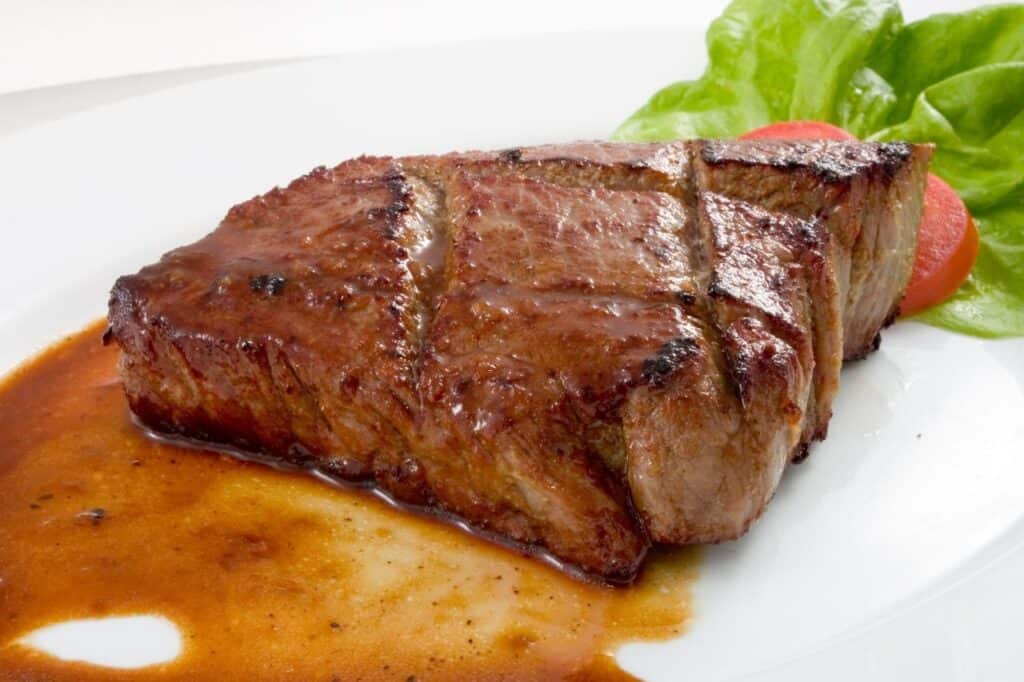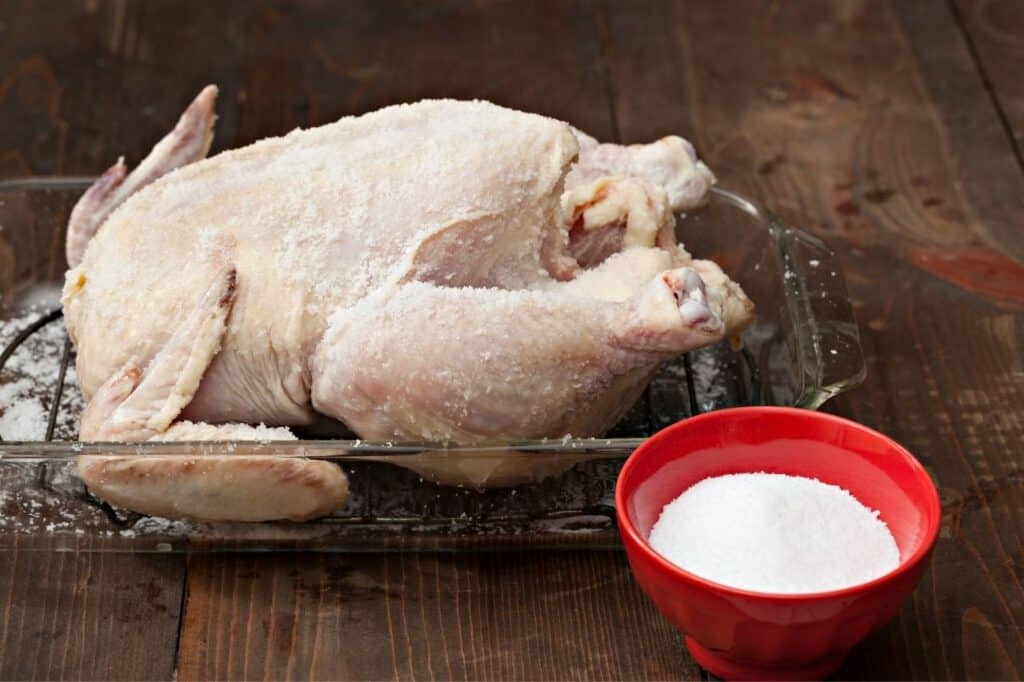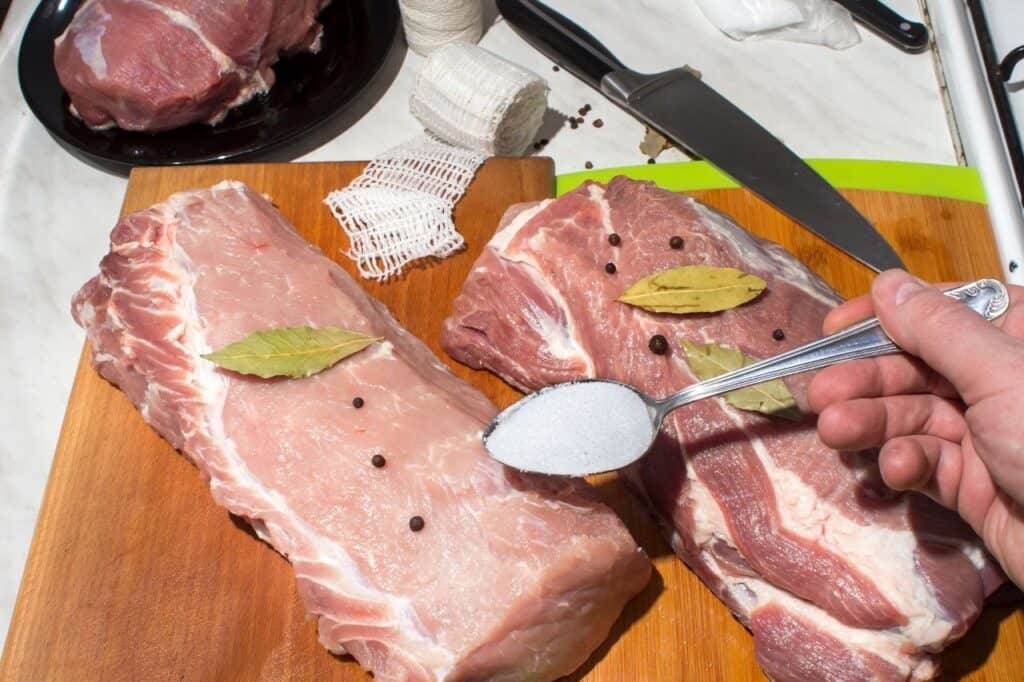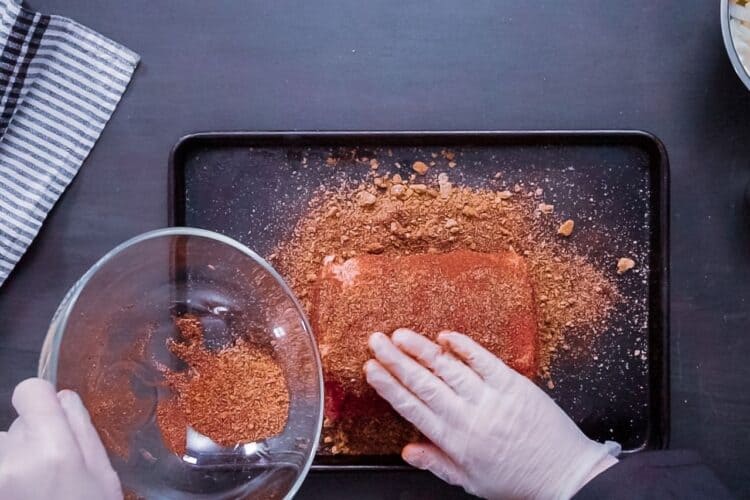When it comes to cooking, people have their own technique on how to get more flavour into their meat. My favourite method is dry brining, which I think most people are not aware of since I get a lot of questions about it. So, here’s everything you need to know about dry brining.
Dry brining in simple terms is salting and letting it rest before cooking the food. Others call it pre-salting. Many people dry brine their meat to achieve a deeply seasoned and juicy meat. It is different from wet brining, which usually results in flavour dilution.
Dry brining is more than just seasoning the meat, there are other benefits you can get from this method.
The What, How, And Why Of Dry Brining
The term dry brining may sound like an intimidating cooking technique but it is actually very simple and easy. The process of dry brining is rubbing salt on the exterior of any raw meat and letting it rest in the fridge before cooking. How long the meat should sit in salt will depend on the type of meat you are dry brining. We’ll get into more details about that later.
Dry brining is practised to enhance the flavour of any meat. By letting the salt seep through the meat it helps bring out the naturally delicious flavour of the meat. Aside from the flavour, salt also helps maintain the moisture in the meat which can result in juicier and more tender meat when cooked. Salt can help break down the proteins of the meat, which leaves the meat more tender. Another benefit of dry brining is achieving brown and crispy skin.
There are two types of brining: dry and wet. The latter is more common. The difference between the two is with wet brining, you make a salt and water solution which is also called brine. You soak your raw meat into the brine solution and let the meat rest. While the two methods of brining produce similar results, many prefer dry brining since the salt is not diluted in the water. This means less use of salt and more space in the fridge.
Additionally, dry brining won’t result in soggy meat which commonly happens with wet brining thinner cuts of meat such as pork chops and steaks. Also, the whole process is much easier than wet brining. However, one downside of dry brining is the process takes longer.
What Are The Benefits Of Dry Brining

More or less wet and dry brining produces the same results. However, I honestly prefer dry brining more than traditional brining. While both have their own advantages and disadvantages, I find dry brining to have more pros. Here are some of them:
Simpler Process
It is easier to rub salt into the meat than soak it with a brine solution. The process is much simpler and faster, plus you don’t need to find a large bowl or bucket that will also fit in the refrigerator. When brining a whole turkey, for instance, isn’t it more convenient to just rub salt on it and place it on a wire rack and pop it inside the fridge? Of course, you can always wet brine your turkey inside a big cooler. But cleaning and sanitizing it before and after can be a lot of work.
In addition to that, dissolving a large amount of salt can take time and you need to be careful with how much salt you put into it. Of course, you can always heat up the brine solution to dissolve the salt faster but then again you need to wait for the water to cool down before you can soak your raw meat.
Retains the Natural Flavours of the Meat
When you dry brine, the meat doesn’t hold extra water weight which typically happens to wet brined meats. When meat holds extra water weight, its natural flavour is diluted. However, when you dry brine, it enhances the meat’s natural flavour.
Deeply Seasoned Meat
To be clear, seasoning your meat with salt right before cooking is different from dry brining, unless you’re cooking seafood. If you want deeply seasoned meat and not just on the surface, dry brining can help you achieve that. Most of the time, simply sprinkling some salt on the food before cooking does not help season it deeply. You won’t get the same level of flavour when you dry brine.
Crispier and Browner Skin
Who doesn’t want a beautifully browned and crispier skin or crust on chicken and steaks? I sure do love my chicken, steaks, and beef roasts to be crunchier. Once the high concentration of salt when dry brining has seeped through the meat, the meat’s surface becomes drier. Dry meat surfaces brown better and faster which reduces the risk of overcooking just to achieve the brown and crispy meat exterior. You won’t achieve this on traditional brine.
Juicy and Firm
Dry brined fish and meat result in a juicier and firmer result. The salt will dissolve the connective tissues and proteins of the meat allowing it to lock in its natural moisture while cooking. For fish that have soft flesh, salt can help firm it up, making it easier to move the fish around without breaking.
How To Dry Brine Different Kinds Of Meats
Turkey
When brining turkey, make sure to thaw it first. Wash it and pat dry with paper towels. Gently massage the skin just to loosen it but don’t remove the skin. For your dry rub, if you want more flavour, you can add other seasonings with your salt. Apply a few teaspoons of your dry rub mixture into the cavity of your turkey. After that, season the outside. Be sure both the meat and skin are seasoned well. You can let the turkey rest in a roasting pan or place it inside a large bag before putting it inside the fridge. Leave the turkey inside for at least 2-3 days.
Chicken

Dry brining a whole chicken is almost similar to turkey. Just follow the steps mentioned above but you need to adjust the measurement and time. Since chicken is a lot smaller than turkey, you can brine it for at least 24-36 hours. If you are dry brining individually cuts of chicken, no need to wait for 24 hours. A few hours should do.
Steaks and Chops
For smaller cuts of pork and beef, use a half teaspoon of salt for every pound. Leave it for 12-24 hours. You can cover or bag the steaks and chops. Some pat-dry the meat after the brining process to remove excess salt deposits but it’s entirely up to you.
Ribs, Brisket, and Prime Rib

Now for meats that are tougher and considerably large, you may need more time to dry brine them. For prime rib, ribs, and brisket, you would want to let them rest for 48 hours or more. Usually, it can take up to 72 hours for cuts that exceed 8 pounds.
Seafood
Yes, you can also dry brine seafood. You probably think that most kinds of seafood have stayed long enough in saltwater, and don’t need the extra salt in them. However, believe me, dry brining them can make a big difference in terms of flavour. If you are cooking shrimps, dry brining them for 15-60 minutes inside the fridge would do. The ratio is one teaspoon for every pound.
For fish, sprinkling salt on the surface with a thin coating of dry brine is enough. Some like to add sugar to their fish so it’s up to you. Since fish are smaller and have softer flesh, you don’t need to wait for an hour. 15-30 minutes will do. Don’t forget to rinse the fish with cold water after the brining process. Yes, you need to wash them first before cooking since salt can easily penetrate the fish’s flesh.
Related Questions
How long you should brine would depend on the type of meat you have. For instance, for turkey, the general rule is to dry brine it for 1 hour per pound, or at least 2 to 3 days. A whole chicken 24-36 hours would do. 12-24 hours is enough for steaks and chops. Prime rib and brisket would take longer, about 48-72 hours, especially for big cuts more than 8 pounds. For seafood 15-60 minutes will do, depending on the type of seafood.
Yes, it is possible to over-dry brine. Dry brining longer than the recommended time can result in drying out of fat under the skin. This is particularly what we wouldn’t want to happen on our meat.
There is no need to wash the meat when the dry brining process is over. Don’t worry because it won’t make your meat overly salty unless you didn’t follow the recommended amount of salt. Rinsing the meat after dry brining will prevent you from achieving a perfectly browned meat surface and crispy and crunchy skin or crust.
- Does Using Pellet Smokers Dry Out Meat? – Myth or Fact - January 4, 2022
- 12 Best Meats To Cook On A Pellet Smoker - December 30, 2021
- Dry Brining: What, How, Why & More - December 28, 2021


